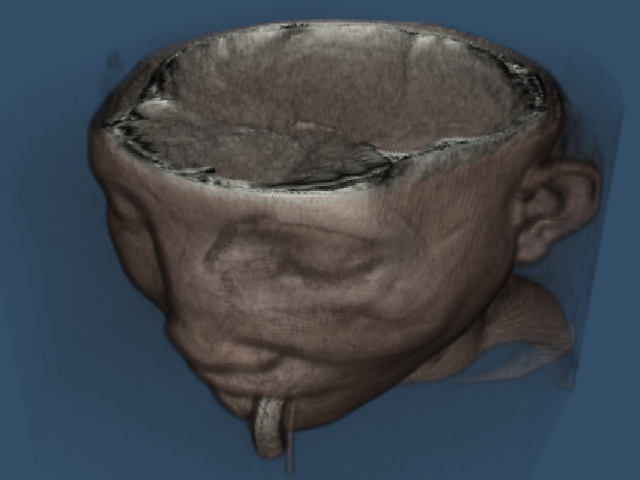MedicalDemo4
Repository source: MedicalDemo4
Description¶
Volume rendering of the dataset.
Usage
MedicalDemo4 FullHead.mhd
Note
This original source code for this example is here.
Info
The example uses src/Testing/Data/FullHead.mhd which references src/Testing/Data/FullHead.raw.gz.
Question
If you have a question about this example, please use the VTK Discourse Forum
Code¶
MedicalDemo4.cxx
// Derived from VTK/Examples/Cxx/Medical4.cxx
// This example reads a volume dataset and displays it via volume rendering.
//
#include <vtkCamera.h>
#include <vtkColorTransferFunction.h>
#include <vtkFixedPointVolumeRayCastMapper.h>
#include <vtkMetaImageReader.h>
#include <vtkNamedColors.h>
#include <vtkNew.h>
#include <vtkPiecewiseFunction.h>
#include <vtkRenderWindow.h>
#include <vtkRenderWindowInteractor.h>
#include <vtkRenderer.h>
#include <vtkVolume.h>
#include <vtkVolumeProperty.h>
#include <array>
int main(int argc, char* argv[])
{
if (argc < 2)
{
cout << "Usage: " << argv[0] << "file.mhd e.g. FullHead.mhd" << endl;
return EXIT_FAILURE;
}
vtkNew<vtkNamedColors> colors;
std::array<unsigned char, 4> bkg{{51, 77, 102, 255}};
colors->SetColor("BkgColor", bkg.data());
// Create the renderer, the render window, and the interactor. The renderer
// draws into the render window, the interactor enables mouse- and
// keyboard-based interaction with the scene.
vtkNew<vtkRenderer> ren;
vtkNew<vtkRenderWindow> renWin;
renWin->AddRenderer(ren);
vtkNew<vtkRenderWindowInteractor> iren;
iren->SetRenderWindow(renWin);
// The following reader is used to read a series of 2D slices (images)
// that compose the volume. The slice dimensions are set, and the
// pixel spacing. The data Endianness must also be specified. The reader
// uses the FilePrefix in combination with the slice number to construct
// filenames using the format FilePrefix.%d. (In this case the FilePrefix
// is the root name of the file: quarter.)
vtkNew<vtkMetaImageReader> reader;
reader->SetFileName(argv[1]);
// The volume will be displayed by ray-cast alpha compositing.
// A ray-cast mapper is needed to do the ray-casting.
vtkNew<vtkFixedPointVolumeRayCastMapper> volumeMapper;
volumeMapper->SetInputConnection(reader->GetOutputPort());
// The color transfer function maps voxel intensities to colors.
// It is modality-specific, and often anatomy-specific as well.
// The goal is to one color for flesh (between 500 and 1000)
// and another color for bone (1150 and over).
vtkNew<vtkColorTransferFunction> volumeColor;
volumeColor->AddRGBPoint(0, 0.0, 0.0, 0.0);
volumeColor->AddRGBPoint(500, 240.0 / 255.0, 184.0 / 255.0, 160.0 / 255.0);
volumeColor->AddRGBPoint(1000, 240.0 / 255.0, 184.0 / 255.0, 160.0 / 255.0);
volumeColor->AddRGBPoint(1150, 1.0, 1.0, 240.0 / 255.0); // Ivory
// The opacity transfer function is used to control the opacity
// of different tissue types.
vtkNew<vtkPiecewiseFunction> volumeScalarOpacity;
volumeScalarOpacity->AddPoint(0, 0.00);
volumeScalarOpacity->AddPoint(500, 0.15);
volumeScalarOpacity->AddPoint(1000, 0.15);
volumeScalarOpacity->AddPoint(1150, 0.85);
// The gradient opacity function is used to decrease the opacity
// in the "flat" regions of the volume while maintaining the opacity
// at the boundaries between tissue types. The gradient is measured
// as the amount by which the intensity changes over unit distance.
// For most medical data, the unit distance is 1mm.
vtkNew<vtkPiecewiseFunction> volumeGradientOpacity;
volumeGradientOpacity->AddPoint(0, 0.0);
volumeGradientOpacity->AddPoint(90, 0.5);
volumeGradientOpacity->AddPoint(100, 1.0);
// The VolumeProperty attaches the color and opacity functions to the
// volume, and sets other volume properties. The interpolation should
// be set to linear to do a high-quality rendering. The ShadeOn option
// turns on directional lighting, which will usually enhance the
// appearance of the volume and make it look more "3D". However,
// the quality of the shading depends on how accurately the gradient
// of the volume can be calculated, and for noisy data the gradient
// estimation will be very poor. The impact of the shading can be
// decreased by increasing the Ambient coefficient while decreasing
// the Diffuse and Specular coefficient. To increase the impact
// of shading, decrease the Ambient and increase the Diffuse and Specular.
vtkNew<vtkVolumeProperty> volumeProperty;
volumeProperty->SetColor(volumeColor);
volumeProperty->SetScalarOpacity(volumeScalarOpacity);
volumeProperty->SetGradientOpacity(volumeGradientOpacity);
volumeProperty->SetInterpolationTypeToLinear();
volumeProperty->ShadeOn();
volumeProperty->SetAmbient(0.4);
volumeProperty->SetDiffuse(0.6);
volumeProperty->SetSpecular(0.2);
// The vtkVolume is a vtkProp3D (like a vtkActor) and controls the position
// and orientation of the volume in world coordinates.
vtkNew<vtkVolume> volume;
volume->SetMapper(volumeMapper);
volume->SetProperty(volumeProperty);
// Finally, add the volume to the renderer
ren->AddViewProp(volume);
// Set up an initial view of the volume. The focal point will be the
// center of the volume, and the camera position will be 400mm to the
// patient's left (which is our right).
vtkCamera* camera = ren->GetActiveCamera();
double* c = volume->GetCenter();
camera->SetViewUp(0, 0, -1);
camera->SetPosition(c[0], c[1] - 400, c[2]);
camera->SetFocalPoint(c[0], c[1], c[2]);
camera->Azimuth(30.0);
camera->Elevation(30.0);
// Set a background color for the renderer
ren->SetBackground(colors->GetColor3d("BkgColor").GetData());
// Increase the size of the render window
renWin->SetSize(640, 480);
renWin->SetWindowName("MedicalDemo4");
// Interact with the data.
renWin->Render();
iren->Start();
return EXIT_SUCCESS;
}
CMakeLists.txt¶
cmake_minimum_required(VERSION 3.12 FATAL_ERROR)
project(MedicalDemo4)
find_package(VTK COMPONENTS
CommonColor
CommonCore
CommonDataModel
IOImage
InteractionStyle
RenderingContextOpenGL2
RenderingCore
RenderingFreeType
RenderingGL2PSOpenGL2
RenderingOpenGL2
RenderingVolume
RenderingVolumeOpenGL2
)
if (NOT VTK_FOUND)
message(FATAL_ERROR "MedicalDemo4: Unable to find the VTK build folder.")
endif()
# Prevent a "command line is too long" failure in Windows.
set(CMAKE_NINJA_FORCE_RESPONSE_FILE "ON" CACHE BOOL "Force Ninja to use response files.")
add_executable(MedicalDemo4 MACOSX_BUNDLE MedicalDemo4.cxx )
target_link_libraries(MedicalDemo4 PRIVATE ${VTK_LIBRARIES}
)
# vtk_module_autoinit is needed
vtk_module_autoinit(
TARGETS MedicalDemo4
MODULES ${VTK_LIBRARIES}
)
Download and Build MedicalDemo4¶
Click here to download MedicalDemo4 and its CMakeLists.txt file. Once the tarball MedicalDemo4.tar has been downloaded and extracted,
cd MedicalDemo4/build
If VTK is installed:
cmake ..
If VTK is not installed but compiled on your system, you will need to specify the path to your VTK build:
cmake -DVTK_DIR:PATH=/home/me/vtk_build ..
Build the project:
make
and run it:
./MedicalDemo4
WINDOWS USERS
Be sure to add the VTK bin directory to your path. This will resolve the VTK dll's at run time.
